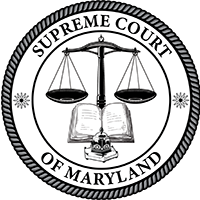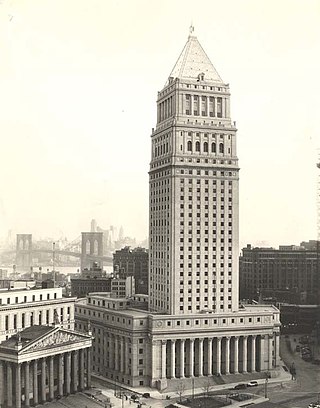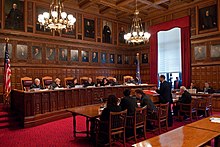
United States appellate procedure involves the rules and regulations for filing appeals in state courts and federal courts. The nature of an appeal can vary greatly depending on the type of case and the rules of the court in the jurisdiction where the case was prosecuted. There are many types of standard of review for appeals, such as de novo and abuse of discretion. However, most appeals begin when a party files a petition for review to a higher court for the purpose of overturning the lower court's decision.
In the United States, a state supreme court is the highest court in the state judiciary of a U.S. state. On matters of state law, the judgment of a state supreme court is considered final and binding in both state and federal courts.
In the United States, a state court is a law court established by a U.S. state that has jurisdiction over disputes with some connection to that state. State's generally provide courts of broad, plenary and general jurisdiction, subject to appeals. State courts handle the vast majority of civil and criminal cases in the United States; the United States federal courts are far smaller in terms of both personnel and caseload, and generally handle cases under federal law, as distinguished from state law.

The United States courts of appeals are the intermediate appellate courts of the United States federal judiciary. The courts of appeals are divided into 13 "Circuits". Eleven of the circuits are numbered "First" through "Eleventh" and cover geographic areas of the United States and hear appeals from the U.S. district courts within their borders. The District of Columbia Circuit covers only Washington, DC. The Federal Circuit hears appeals from federal courts across the United States in cases involving certain specialized areas of law. The courts of appeals also hear appeals from some administrative agency decisions and rulemaking, with by far the largest share of these cases heard by the D.C. Circuit. Appeals from decisions of the courts of appeals can be taken to the U.S. Supreme Court.
In law, certiorari is a court process to seek judicial review of a decision of a lower court or government agency. Certiorari comes from the name of an English prerogative writ, issued by a superior court to direct that the record of the lower court be sent to the superior court for review. The term is Latin for "to be made more certain", and comes from the opening line of such writs, which traditionally began with the Latin words "Certiorari volumus...".
A writ of coram nobis is a legal order allowing a court to correct its original judgment upon discovery of a fundamental error that did not appear in the records of the original judgment's proceedings and that would have prevented the judgment from being pronounced. The term coram nobis is Latin for "before us" and the meaning of its full form, quae coram nobis resident, is "which [things] remain in our presence". The writ of coram nobis originated in the courts of common law in the English legal system during the sixteenth century.

The Supreme Court of Maryland is the highest court of the U.S. state of Maryland. The court, which is composed of one chief justice and six associate justices, meets in the Robert C. Murphy Courts of Appeal Building in the state capital, Annapolis. The term of the Court begins the second Monday of September. The Court is unique among American courts in that the justices wear red robes.
Discretionary review is the authority appellate courts have to decide which appeals they will consider from among the cases submitted to them. This offers the judiciary a filter on what types of cases are appealed, because judges have to consider in advance which cases will be accepted. The appeals court will then be able to decide substantive cases with the lowest opportunity cost. The opposite of discretionary review is any review mandated by statute, which guides appellate courts about what they can and cannot do during the review process.
Discretionary jurisdiction is a power that allows a court to engage in discretionary review. This power gives a court the authority to decide whether to hear a particular case brought before it. Typically, courts of last resort and intermediate courts in a state or country will have discretionary jurisdiction. In contrast, the lower courts have no such power. For this reason, the lower courts must entertain any case properly filed, so long as the court has subject matter jurisdiction over the questions of law and in personam jurisdiction over the parties to the case. Customarily a court is granted the power by rule, statute, or constitutional provision. When a constitutional provision establishes the court's power, it will have more limitations on its screening process. The usual intent behind granting power through a constitutional provision is to maintain decisional uniformity.
An interlocutory appeal, in the law of civil procedure in the United States, occurs when a ruling by a trial court is appealed while other aspects of the case are still proceeding. Interlocutory appeals are allowed only under specific circumstances, which are laid down by the federal and the separate state courts.
The Judiciary Act of 1925, also known as the Judge's Bill or Certiorari Act, was an act of the United States Congress that sought to reduce the workload of the Supreme Court of the United States.
Commodity Futures Trading Commission v. Schor, 478 U.S. 833 (1986), was a case in which the Supreme Court of the United States held an administrative agency may, in some cases, exert jurisdiction over state-law counterclaims.

In most legal jurisdictions, a supreme court, also known as a court of last resort, apex court, and highcourt of appeal, is the highest court within the hierarchy of courts. Broadly speaking, the decisions of a supreme court are not subject to further review by any other court. Supreme courts typically function primarily as appellate courts, hearing appeals from decisions of lower trial courts, or from intermediate-level appellate courts.

In United States federal courts, a circuit split, also known as a split of authority or split in authority, occurs when two or more different circuit courts of appeals provide conflicting rulings on the same legal issue. The existence of a circuit split is one of the factors that the Supreme Court of the United States considers when deciding whether to grant review of a case. Some scholars suggest that the Supreme Court is more likely to grant review of a case to resolve a circuit split than for any other reason.
Griffin v. Illinois, 351 U.S. 12 (1956), was a case in which United States Supreme Court held that a criminal defendant may not be denied the right to appeal by inability to pay for a trial transcript.

In the law of the United States, a certified question is a formal request by one court from another court, usually but not always in another jurisdiction, for an opinion on a question of law.
United States v. More, 7 U.S. 159 (1805), was a United States Supreme Court case in which the Court held that it had no jurisdiction to hear appeals from criminal cases in the circuit courts by writs of error. Relying on the Exceptions Clause, More held that Congress's enumerated grants of appellate jurisdiction to the Court operated as an exercise of Congress's power to eliminate all other forms of appellate jurisdiction.

A certificate of division was a source of appellate jurisdiction from the circuit courts to the Supreme Court of the United States from 1802 to 1911. Created by the Judiciary Act of 1802, the certification procedure was available only where the circuit court sat with a full panel of two: both the resident district judge and the circuit-riding Supreme Court justice. As Chief Justice John Marshall wrote, he did not have "the privilege of dividing the court when alone."

In some jurisdictions, a petition for review is a formal request for an appellate tribunal to review the decision of a lower court or administrative body. If a jurisdiction utilizes petitions for review, then parties seeking appellate review of their case may submit a formal petition for review to an appropriate court. In United States federal courts, the term "petition for review" is also used to describe petitions that seek review of federal agency actions.









